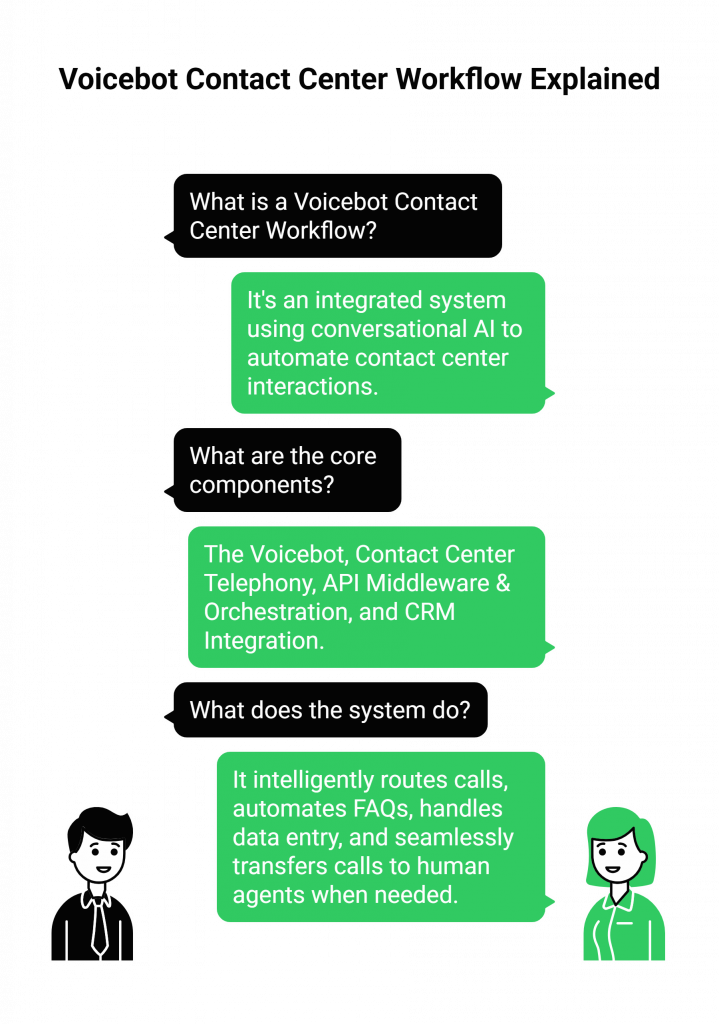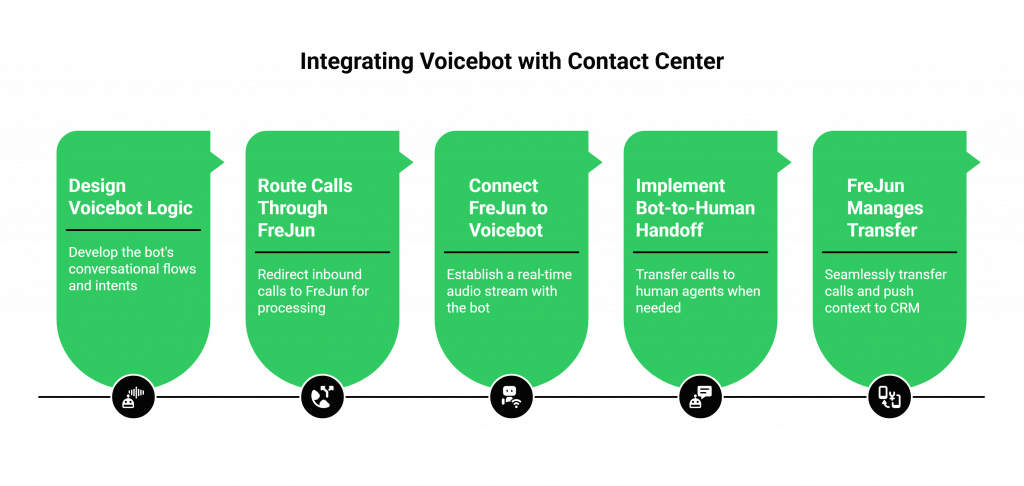The modern contact center is at a crossroads. On one side, you have sophisticated AI and voicebots capable of handling complex, natural language conversations. On the other, you have established telephony and CRM systems that are the backbone of your customer service operations. The dream is to merge them, creating a seamless Voicebot Contact Center workflow where routine calls are automated intelligently, and human agents are freed up to handle the most critical issues.
Table of contents
- What is a Voicebot Contact Center Workflow?
- The Integration Trap: Why Most Voicebot Projects Stall
- FreJun: The API-First Bridge for Your Contact Center
- The Traditional Approach vs. The FreJun API: A Comparison
- How to Add a Voicebot Contact Center Workflow? A 5-Step Guide
- Best Practices for a Flawless Voicebot Integration
- Final Thoughts: From a Cost Center to an Experience Hub
- Frequently Asked Questions (FAQ)
This integration promises a future of unparalleled efficiency and enhanced customer experience. However, many businesses that embark on this journey find themselves caught in a technical quagmire. The process of connecting a modern, agile voicebot to the rigid, often legacy, infrastructure of a traditional contact center is fraught with complexity, creating a barrier that can stall even the most promising AI initiatives.
What is a Voicebot Contact Center Workflow?

A Voicebot Contact Center workflow is an integrated system that uses conversational AI to automate interactions within a contact center environment. It’s more than just a simple IVR (Interactive Voice Response); it’s a dynamic, intelligent process. The core components include:
- The Voicebot: The AI-powered agent that uses speech recognition (ASR), natural language processing (NLP), and text-to-speech (TTS) to converse with customers.
- Contact Center Telephony: The underlying SIP-based or cloud telephony system that manages the phone calls.
- API Middleware & Orchestration: The crucial “glue” that connects the voicebot to the telephony system and other business tools.
- CRM Integration: The connection to your customer database, providing the voicebot and human agents with the context needed for personalized service.
When these components work in harmony, the system can intelligently route calls, automate FAQs, handle data entry, and seamlessly transfer a call along with the full conversation history to a human agent when necessary.
The Integration Trap: Why Most Voicebot Projects Stall
You have a powerful voicebot and a reliable contact center. The challenge lies in making them talk to each other. This is the integration trap where most projects get stuck. The traditional approach is notoriously difficult:
- Complex SIP Integration: You need to establish and maintain a direct SIP (Session Initiation Protocol) connection between your bot’s platform and your contact center’s telephony gateway. This requires deep telecom expertise and is often a brittle, inflexible setup.
- Rigid IVR Configurations: You have to reprogram your existing IVR system to create a new “node” that redirects calls to the voicebot. This is often a slow, cumbersome process that requires vendor support.
- Loss of Context: Passing the conversation history from the bot to the human agent is a major challenge. It often involves custom solutions like passing data through SIP headers, which are difficult to implement and may not be supported by all systems.
- Lack of Flexibility: Once you build this rigid connection, making changes like updating the bot’s logic or changing the escalation path becomes a significant effort, stifling iteration and improvement.
This is why so many brilliant voicebot projects fail to get off the ground. The focus shifts from creating a great customer experience to wrestling with archaic telephony protocols.
FreJun: The API-First Bridge for Your Contact Center
This is the exact problem FreJun was built to solve. We are not another AI voicebot platform. We are the specialized voice infrastructure layer that provides a simple, powerful API to create a modern Voicebot Contact Center workflow.
FreJun acts as the flexible, intelligent middleware that connects your AI to your existing contact center infrastructure, without the need for complex, direct SIP integrations.
- We are AI-Agnostic: You bring your own voicebot “brain.” Whether it’s from LivePerson, Convin, or a custom-built AI stack, our platform can connect to it.
- We Integrate with Your Existing Systems: We can seamlessly forward calls to your contact center’s existing agent queues, passing along rich context via API.
- We Provide a Simple, Developer-First API: We handle all the complexities of real-time audio streaming and call control. Your developers can focus on building the best conversational logic, not on debugging SIP headers.
With FreJun, you can build a flexible, scalable, and intelligent Voicebot Contact Center in a fraction of the time, and with a fraction of the headache.
Key Takeaway
The hardest part of building a Voicebot Contact Center is not the AI; it’s the integration with your telephony infrastructure. The traditional approach is slow, rigid, and complex. FreJun provides a modern, API-first alternative. By acting as the intelligent bridge between your AI and your contact center, we allow you to build a powerful, flexible, and scalable solution without needing to become a telecom expert.
The Traditional Approach vs. The FreJun API: A Comparison
| Feature | The Traditional Integration Approach | The FreJun API-First Approach |
| Integration Method | Direct, complex SIP trunking and rigid IVR configuration. | Simple API integration and flexible call forwarding. |
| Flexibility | Low. Changes to call flows or bot logic are difficult and slow to implement. | High. All call flows and business logic are managed programmatically via API, allowing for rapid iteration. |
| Context Handoff | Difficult. Often requires custom SIP header solutions. | Easy. Full conversation context and customer data are passed to the agent via a simple API call. |
| Developer Focus | Wrestling with low-level telephony protocols. | Building intelligent conversational logic and business workflows. |
| Time to Deployment | Months. Requires deep telecom expertise and vendor coordination. | Days or weeks. Built for modern, agile development teams. |
| Scalability | Limited by the capacity of the direct SIP connection and IVR hardware. | Built on a globally distributed, enterprise-grade cloud platform that scales on demand. |
How to Add a Voicebot Contact Center Workflow? A 5-Step Guide
This guide outlines the modern, FreJun-powered approach to integrating your voicebot with your contact center.

Step 1: Design Your Voicebot’s Conversational Logic
First, build your bot’s “brain.” Design the conversational flows, define the intents it can handle, and create the fallback scenarios for when it needs to escalate to a human. This is your core AI logic.
Step 2: Route Your Inbound Calls Through FreJun
Instead of sending calls directly to your contact center’s IVR, you port your main support number to FreJun or forward your calls to a FreJun-provisioned number. This makes FreJun the new front door for all your voice interactions.
Step 3: Connect FreJun to Your Voicebot
In the FreJun dashboard, you configure your number’s webhook to point to your voicebot’s backend API endpoint. When a call comes in, FreJun establishes a real-time, bi-directional audio stream with your bot, allowing the conversation to begin.
Step 4: Implement the Bot-to-Human Handoff
This is the most critical part of the Voicebot Contact Center workflow. When your bot determines a human agent is need, your backend makes a simple API call to FreJun with two key pieces of information:
- The phone number or queue extension of the human agent/department in your existing contact center.
- A payload of data containing the full context of the conversation (e.g., customer ID, issue type, and a transcript of the bot interaction).
Step 5: FreJun Manages the Transfer
FreJun seamlessly transfers the live call to the specified agent in your contact center. Simultaneously, our API pushes the conversation context directly into your CRM or helpdesk software, so the agent’s screen is ready with all the relevant information before they even say “hello.”
Best Practices for a Flawless Voicebot Integration
- Maintain Session Context: The key to a good customer experience is ensuring the human agent knows everything the bot has already discussed. Use FreJun’s API to pass this context reliably.
- Optimize for Low Latency: A natural conversation requires a fast response. Ensure your entire pipeline from FreJun to your bot and back, is optimized for real-time interaction.
- Design Clear Escalation Paths: Program your bot’s logic to recognize when it’s out of its depth. Frustration, specific keywords, or multiple failed attempts should be clear triggers for a human handoff.
- Continuously Analyze and Improve: Use the analytics from both your bot and your contact center to understand how your workflow is performing. Use these insights to refine your bot’s logic and improve first-call resolution rates.
Final Thoughts: From a Cost Center to an Experience Hub
The integration of a Voicebot Contact Center workflow is more than just a technical upgrade; it’s a strategic transformation. It’s about turning your contact center from a reactive cost center into a proactive, intelligent experience hub. But this transformation is only possible if the integration is done right.
The old way of doing things with rigid SIP trunks and cumbersome IVR configurations is a barrier to innovation. The modern, API-first approach is the key to unlocking the true potential of your AI. By leveraging a specialized voice infrastructure platform like FreJun, you can build a solution that is not only powerful and intelligent but also flexible, scalable, and ready for the future.
Further Reading – Add Voice Chatbot Online to Your SaaS Product
Frequently Asked Questions (FAQ)
No, it integrates with it. FreJun acts as the intelligent front door and the middleware. We receive the call, let your voicebot handle the initial interaction, and then seamlessly transfer the call to your existing agent queues, enriching the process with full context.
Yes. Since we can transfer a call to any standard phone number or SIP endpoint, our platform is compatible with virtually all modern contact center systems.
You can use any voicebot that can be accessed via an API. Our platform is model-agnostic, giving you the freedom to choose the best AI for your needs.
When your backend instructs FreJun to transfer a call, you can include a payload of data. Our platform can then make a separate API call to your CRM or helpdesk software to post this data, so it appears on the agent’s screen when they receive the call.
Absolutely. You can use FreJun’s API to initiate outbound calls with your voicebot for use cases like appointment reminders or feedback surveys, with the option to connect the customer to a live agent at any point during the conversation.
